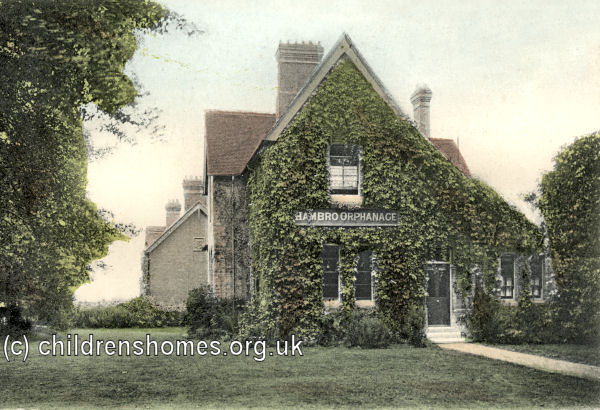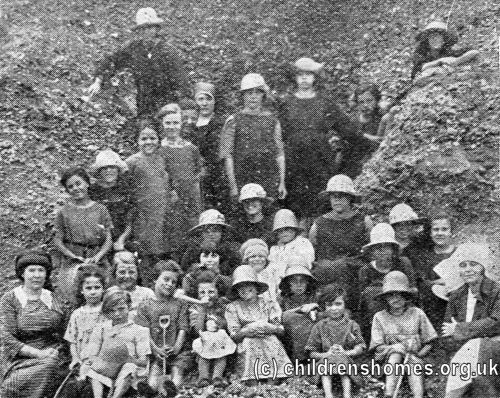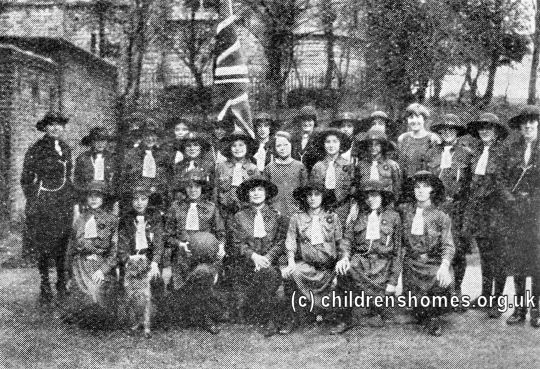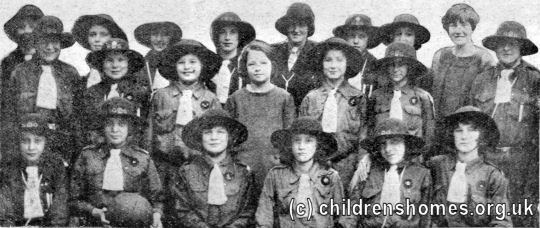The Hambro House Orphanage / Hambro Home for Girls, Roehampton, London
The Hambro House Home was founded in 1879 at Treville Street, Putney Heath, Roehampton. Its object was to receive girls who were orphans or fatherless, and to support, educate and train them for domestic service. Candidates for admission were required to be between 4 and 11 years old and proposed by a donor of ten guineas or more, or by annual subscriber of one guinea. Applicants had to provide a certificate of their parents' marriage and a medical certificate of good health. A charge of £12 per annum was made for each girl, payable in advance either monthly or quarterly. Admission could also be obtained by payment of a lump sum, the amount depending on the age; for a girl of four or five years old the charge was £90. Inmates remained until they were 15 years of age and could be retained as paid servants in the home if vacancies occurred. The home was also certified to take girls placed by the Boards of Guardians who ran the poor relief and workhouse system. In 1900, the home could accommodate 27 girls.

Hambro Orphanage for Girls, Roehampton, c.1907. © Peter Higginbotham
In 1919, the home was taken over by the Waifs and Strays Society and became the Hambro Home for Girls. Under the Society's management, the home was used to house 27 girls aged from 5 to 12.

Hambro Home for Girls, Roehampton, c.1923. © Peter Higginbotham
The building was extended by the addition of a new wing, opened in October 1924 by the Mayoress of Wandsworth and dedicated by the Vicar of Roehampton, the Rev. Henry Elkerton. The extra space appears not to have increased the overall capacity of the home but did widen the age range which now went from 3 to 16 years.

Hambro Home for Girls, Roehampton, c.1926. © Peter Higginbotham
The girls contributed to much household work of the home, including helping with the cooking.

Kitchen at Hambro Home for Girls, Roehampton, c.1929. © Peter Higginbotham
In summer, the girls were usually taken on holiday for two weeks holiday — often doing an exchange of premises with one of the other homes. In 1922, they stayed at the Southsea home and in 1923 at Southbourne.

Hambro Home Girls at Southbourne, 1923. © Peter Higginbotham
Girls at the home were enthusiastic members of the Girl Guides.

Hambro Home Girl Guides, Roehampton, c.1927. © Peter Higginbotham

Hambro Home Girl Guides, Roehampton, c.1932. © Peter Higginbotham
With the outbreak of the Second World War in 1939, the girls were dispersed to a number of other Society homes. The home re-opened in 1946, now housing boys as well as girls.
The home received a special treat in 1964 when the Beatles paid a visit to help the children paint eggs for their Easter display.
The home finally closed in 1975. The property is now in private residential use.
Records
Note: many repositories impose a closure period of up to 100 years for records identifying individuals. Before travelling a long distance, always check that the records you want to consult will be available.
- Index of the Society's first 30,000 children's case files ordered by surname.
- Index of the Society's first 30,000 children's case files ordered by date of birth.
- The Children's Society Records and Archive Centre is at Unit 25, Springfield House, 5 Tyssen Street, London E8 2LZ (email: archives@childrenssociety.org.uk). Files for children admitted to its homes after September 1926 were microfilmed in the 1980s and the originals destroyed. Some post-1926 files had already been damaged or destroyed during a flood. The Society's Post-Adoption and Care Service provides access to records, information, advice, birth record counselling, tracing and intermediary service for people who were in care or adopted through the Society.
- The Society has produced detailed catalogues of its records relating to disabled children, and of records relating to the Children's Union (a fundraising body mostly supported from the contributions of children).
- The National Archives, Kew, Richmond, Surrey, TW9 4DU. File BN 62/2926 — Reports of visits (1964-71).
Bibliography
- Bowder, Bill Children First: a photo-history of England's children in need (1980, Mowbray)
- Church of England Waifs and Strays' Society [Rudolfe, Edward de Montjoie] The First Forty Years: a chronicle of the Church of England Waifs and Strays' Society 1881-1920 (1922, Church of England Waifs and Strays' Society / S.P.C.K.)
- Higginbotham, Peter Children's Homes: A History of Institutional Care for Britain's Young (2017, Pen & Sword)
- Morris, Lester The Violets Are Mine: Tales of an Unwanted Orphan (2011, Xlibris Corporation) — memoir of a boy growing up in several of the Society's homes (Princes Risborough, Ashdon, Hunstanton, Leicester) in the 1940s and 50s.
- Rudolf, Mildred de Montjoie Everybody's Children: the story of the Church of England Children's Society 1921-1948 (1950, OUP)
- Stroud, John Thirteen Penny Stamps: the story of the Church of England Children's Society (Waifs and Strays) from 1881 to the 1970s (1971, Hodder and Stoughton)
Links
- Hidden Lives Revealed — the story of the children who were in the care of The Children's Society in late Victorian and early 20th Century Britain.
- The Children's Society
Except where indicated, this page () © Peter Higginbotham. Contents may not be reproduced without permission.


